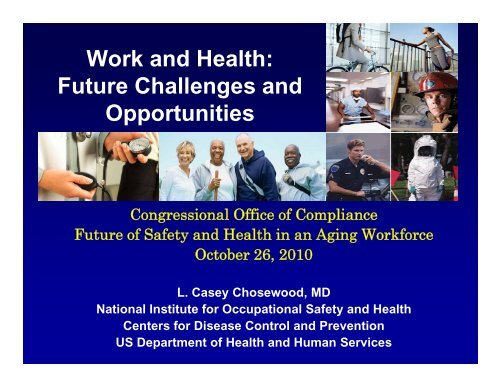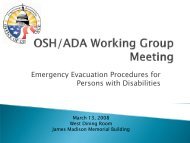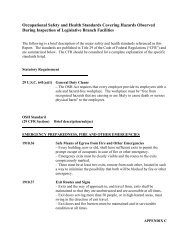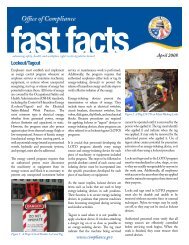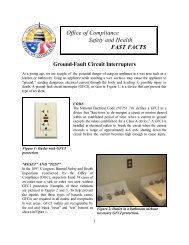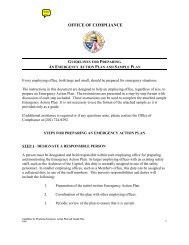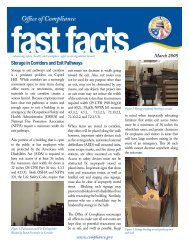Work and Health Future Challenges and Opportunities
Work and Health: Future Challenges and Opportunities Opportunities
Work and Health: Future Challenges and Opportunities Opportunities
Create successful ePaper yourself
Turn your PDF publications into a flip-book with our unique Google optimized e-Paper software.
<strong>Work</strong> <strong>and</strong> <strong>Health</strong>:<strong>Future</strong> <strong>Challenges</strong> <strong>and</strong><strong>Opportunities</strong>Congressional Office of Compliance<strong>Future</strong> of Safety <strong>and</strong> <strong>Health</strong> in an Aging <strong>Work</strong>forceOctober 26, 2010L. Casey Chosewood, MDNational Institute for Occupational Safety <strong>and</strong> <strong>Health</strong>Centers for Disease Control <strong>and</strong> PreventionUS Department of <strong>Health</strong> <strong>and</strong> Human Services
Some Unknowns: 21 st Century <strong>Work</strong>forceImmigrationOutsourcingRe-careering• Will nations change policies to encourageor discourage immigration? i • Will wage competition increase?• Does it portend a global workforce?• How do employers taken on global healthissues?• Will more workers remain in theworkforce <strong>and</strong> take on an “encore” career?• Who will manage associated chronichealth conditions?• Will hurdles to continued work at olderages be removed?
Selected <strong>Work</strong>force <strong>Challenges</strong>Limited availability of workersChronologically gifted<strong>Health</strong>-challenged younger workersInnovative Employment ArrangementsGlobal Competition for <strong>Work</strong>ersEncore Careers vs. RetirementAge-Related <strong>Challenges</strong> for Occupational <strong>Health</strong><strong>and</strong> SafetySocial Benefits & Age DiscriminationResponsibility for the <strong>Health</strong> of <strong>Work</strong>ers
Growing Shortage of U.S. <strong>Work</strong>ersExpected Labor Force <strong>and</strong> Labor Force Dem<strong>and</strong>250200Millions of People15010050Labor NeededLabor Available0200220042006200820102012201420162018202020222024202620282030Source: Employment Policy Foundation analysis <strong>and</strong>projections of Census/BLS <strong>and</strong> BEA data.
Screeching to a Halt:Growth in the <strong>Work</strong>ing-Age Population200%1970-20102010-2050150%100%50%0%-50%Mexico Brazil India China South Australia Canada US Netherl<strong>and</strong>s Spain France UK Russia Italy Japan GermanyKoreaSource: Deloitte Research/UN Population Division (http://esa.un.org/unpp/) It’s 2008: Do YouKnow Where Your Talent Is? Why Acquisition <strong>and</strong> Retention Strategies Don’t <strong>Work</strong>, p.6
Dramatically Different Patterns ofGrowth by AgePercent Growth in U.S. Population by Age: 2000-201080%Rapid growth in the over-55 workforce60%48%40%20%0%-20%18%15%5% 5%Few younger workersentering-9%16-24 25-34 35-44 45-54 55-64 65+Age of <strong>Work</strong>ersDeclining number of mid-career workersSource: U.S. Census Bureau. 2000
. . . Continuing Into the <strong>Future</strong>Percent Growth in U.S. <strong>Work</strong>force by Age: 2000-202080%73%60%54%40%20%0%7% 8% 7%3%-20%-10%under 14 15-24 25-34 35-44 45-55 55-64 65+Age of <strong>Work</strong>ersSource: U.S. Census Bureau
In 2000, A Fairly “Young” World . . .Under 5% 5% to 12.4% 12.5% to 20% Above 20%Percent of Population Age 60+ in 2000Source: U.S. Census Bureau, 2000
. . . Rapidly Aging by 2025Under 5% 5% to 12.4% 12.5% to 20% Above 20%Percent of Population Age 60+ in 2025Source: U.S. Census Bureau,. 2000
Age8070Why?“Sudden” Boom in Life ExpectancyLife Expectancy at Birth: 1000 - 200076.560504740302530353638201001000 1200 1400 1600 1800 1900 2000Source: U.S. Census Bureau, 2000
76And a Dramatic Drop in Birth RatesTotal Fertility Rate: 1960 ▀ <strong>and</strong> 2000 ▀1960 20005.9Tota al Fertility Ra ate54323.32.03.628 2.8 2.91.7 1.7 1.62.02.5 2.51.4 1.3 1.24.01.83.110US UK France Canada Japan Germany Italy China IndiaSource: Age Wave
Why? The Baby Boom PatternThe Boom Years: 1946-19644.54.03.5Birth in Millions30 3.02.52.01930 1940 1950 1960 1970 1980 1990Source: U.S. Census Bureau International Data Base
What is health?Am I healthy?Do I care if others in my life are healthy?What influences my health?Where do I go for help with my health?How can I change my health?I’ve Lost my health, now what?13
<strong>Health</strong> challenges of the younger,older <strong>and</strong> those s<strong>and</strong>wiched between
Diabesity <strong>and</strong> the <strong>Future</strong> <strong>Work</strong>force• 39 States with 40% of young adults considered to beoverweight or obese in just last decade!– In Kentucky, Alabama <strong>and</strong> Mississippi, >50% youngadults are overweight• Medical Consequences:– High Blood Pressure– High Fats in the Blood– Type 2 Diabetes (formerly called adult-onset)– Hepatic steatosis epidemic (fat deposits in the liver)– Sleep apnea (too much fat around the upper airway)• Psychological stress• Musculoskeletal disorders– what the old <strong>and</strong> the young worker share
Childhood Obesity by Country
US Childhood Obesity: 1960 - 2002
Too Fat to Fight• Since 1995, proportion of recruits whofailed their physical exams becausethey were overweight has risen bynearly 70%.• Being overweight is now the leadingmedical reason for rejection.
Global Competition for <strong>Work</strong>ers• Migration of talent now plays an important role in shapingskilled workforces• In 1990s, U.S. benefited from inward migration– Brain drain <strong>and</strong> remittances dominated policy• In 2000s, more opportunities in sending countries– India, Brazil, China, Europe, Africa, South America• Increased Mobility = internationalization of the labor market• Global competition for talent is growing fast– Previously favored nations like U.S. cannot count on having nocompetition for acquiring skilled workers– MNEs now face global health issues involving their employees• Not just chronic “American-type” diseases• Acute infectious diseases that are more prevalent in foreign countries• Most employer-based health promotion programs are based on American model
Innovative Employment Arrangements• “Flexible” or “Precarious”• Contingent = work without promise of longevity• Evidence that contingent workers are at higher risk forwork-related injury, illness, <strong>and</strong> death:– Outsourcing of more hazardous jobs– Lack of experience <strong>and</strong> familiarity with operations in a dangerousworkplace– Inadequate safety training i <strong>and</strong> protective ti equipment– Limited access to preventive measures such as medical screeningprograms– Components of current health <strong>and</strong> safety regulations, <strong>and</strong> theworkers' compensation system, which were designed in an era ofdifferent employment arrangements, play a role.• Does your employee wellness program cover all persons whowork for you or your contactors or not?
Webster's Definition of Retirement• to disappear• to go away• to withdrawSource: Webster's New Twentieth Century Dictionary
More Years Spent in “Retirement”After First Career353030 +Years2520151013.619.420-25501.21900 1980 1990 2000 2010Source: Age Wave, based on U.S. data, <strong>and</strong>The Concours Group
Aging Productively
Impact on Occupational Safety <strong>and</strong> <strong>Health</strong>EMPL LOYEESSeniorExecutivesHumanResourceLeadersFront LineManagersChanging workforcedemographics meanthat we all need tobe thoughtful abouthow to age <strong>and</strong> workproductively.Is aging alwayscompulsory?
Proportion of 50 yr-olds Still Employedat Subsequent Agesby Age Attained <strong>and</strong> Class (U.S.)80706050403020606570100White Collar Blue Collar ServiceUS Bureau of Census 1981-2000
Aging <strong>Work</strong>force <strong>and</strong> Social Security• Social Security– In 1935, average life span at birth was 62– So, retirement benefits started at 65!– Rising costs impacts discretionary spending• Changing g pension systems– Greece• Raised retirement from 63 from 61• Banned early retirement altogether– Other nations facing pension pressures?– Effect on blue collar workers?
Aging: g A Balance of Factors• Possible Limitations– Cognitive Limitations– Chronic Conditions– Physical Capacity• Compensating Factors– Attitude– Judgment– Flexibility– Interest in learning
• Laboratory Tests– Cognition speedMental Capacity• Information retrieval slower, unless material isfamiliar– Learning <strong>and</strong> recall slower, but equallysuccessful in the end– Greater retention, higher learningachievement <strong>and</strong> more likely to complete anew field of study than younger workers
Mental Capacity:Relevance to On-the-Job Performance• Lab tests do not translate well to actual worksettings• Factors other than psychometric cognitiveabilities appear important to perform well atwork– How well worker gets along with co-workers– Desire to perform well• Individual measures are quite sensitive toqoccupational class
Age <strong>and</strong> Chronic Medical Conditions
<strong>Work</strong>ers with >1 ChronicCondition by Age (U.S.)706050403020100>151-64 65-74 75+ Non-workersHRS 1998
Exposure to Physical StressorsEU - 1990-200050403020100Painful/Tiring PositionsH<strong>and</strong>ling Heavy Loads1990 1995 2000<strong>Work</strong>ing Conditions in the EU – Euro. Fnd.
Exposure to Physical HazardsBy Type of <strong>Work</strong> Contract6050403020100RepetitiveTasksRepetitiveMovementPainful/Tiring<strong>Work</strong> PosturesPermanent Employment Fixed-term Temporary<strong>Work</strong>ing Conditions in the EU – Euro. Fnd.
Physical Capacity: Can Older <strong>Work</strong>ers Keep Up?• Physiology Facts– Maximal strength at 20-30 years–O 2 uptake reduced to 70% (max) by 65 years– Older adults work closer to capacity!• Decreased Performance, Yes But …– For physically dem<strong>and</strong>ing work only–<strong>Work</strong> uncommonly dem<strong>and</strong>s maximal effort• Non-physical advantages that older workersbring to a job are rarely measured instudies!
Physical Capacity: Match Task to Ability!• Maintaining musculoskeletal health will beincreasingly important• <strong>Work</strong>ers abilities matched to the job:– Results in less morbidity– Based on practical ergonomic principles– Accommodation practices not fully integrated yetinto employment practices:• May change with ADA Amendments Act of2008• Increases chances lawsuit will go to trial
Essential Points About Aging• Do aging workers need specialaccommodations?– A well-designed d workplace benefits everyone– <strong>Work</strong> stations <strong>and</strong> job tasks need to be matched to thecapacity of each worker– There should be no conflict between ergonomic principlesvs. reasonable accommodations• Are there any specific health <strong>and</strong> safetyconcerns related to aging workers?– Older workers have fewer injuries, but when one occurs, thatinjury tends to be more severe <strong>and</strong> it takes worker longer toget better.– Injuries differ in older workers—there are moremusculoskeletal injuries– No consistent relationship between aging <strong>and</strong> workperformance!
Providing <strong>Opportunities</strong> for <strong>Health</strong> toEmerge at <strong>Work</strong>44
What’s the Evidence-Base for Employee<strong>Health</strong> Promotion Practices?• Evidence:– More than opinion or testimony• “…Growing body of empirical evidence*– Large proportion of diseases are preventable (risks are modifiable)– Risk-dependent diseases are costly & reduce worker productivitywithin short time window– Targeting risk behaviors can decrease costs <strong>and</strong> increaseproductivity– <strong>Work</strong>site health promotion <strong>and</strong> disease prevention programs savecompanies money <strong>and</strong> produce + ROI* Goetzel & Reuters, Value in <strong>Health</strong> Care , IOM (2010)
Integration of Traditional Occupational<strong>Health</strong> with <strong>Health</strong> Promotion<strong>Work</strong>Lifewww.cdc.gov/niosh/worklife• <strong>Work</strong>Life Centers of Excellence• Essential Elements of Effective<strong>Work</strong>place Programs for <strong>Health</strong> <strong>and</strong>Safety• Resources Page: 99 Web-LinksWorth Having46
<strong>Work</strong>Life• Protect existing health <strong>and</strong> safety• Provide respect to workers• Build a healthy environment• Develop underst<strong>and</strong>ing <strong>and</strong>partnership• Seek to engage• Recognize need for flexibility <strong>and</strong>autonomy• Integrate safety <strong>and</strong> health atevery opportunity47
<strong>Work</strong>LifeExamples of Integrated Programs– Respiratory protection programs thatcomprehensively address tobacco abuse– Ergonomic consultations that also discussarthritis management strategies– Stress management efforts that first seek todiminish workplace stressors, <strong>and</strong> only thenwork on building worker resiliency– Integrated training <strong>and</strong> prevention programs(falls, motor vehicle safety, first aid, hearingconservation, stretching, flexibility <strong>and</strong> liftingprograms)
Selected References• National Research Council. <strong>Health</strong> <strong>and</strong> Safety Needs of Older <strong>Work</strong>ers,National Academies Press (2004).• Dychtwald K, Erickson T, Morison, B. It’s Time to Retire Retirement, HarvardBusiness Review (March 2006).• GAO. Older <strong>Work</strong>ers: Enhanced Communication among Federal AgenciesCould Improve Strategies for Hiring <strong>and</strong> Retaining Experienced <strong>Work</strong>ers.GAO-09-206 (February 24, 2009).• GAO. Older <strong>Work</strong>ers: Some Best Practices <strong>and</strong> Strategies for Engaging <strong>and</strong>Retaining Older <strong>Work</strong>ers. GAO-07-433T (February 28, 2007).• Johnson, Richard et al. Older <strong>Work</strong>ers on the Move: Recareering in Later Life(2009), AARP Public Policy Institute• National Institute t on Aging. Growing Older in America: The <strong>Health</strong> <strong>and</strong>Retirement Study. Available athttp://www.nia.nih.gov/ResearchInformation/ExtramuralPrograms/BehavioralAndSocialResearch/HRS.htm• Report of the Taskforce on the Aging of the American <strong>Work</strong>force (2008).Available athttp://www.aging.senate.gov/letters/agingworkforcetaskforcereport.pdf• RW Johnson et al. <strong>Work</strong> Impediments at Older Ages (2006). Available athttp://www.urban.org/UploadedPDF/311313_work_impediments.pdfwork pdf• Solving the Problem of Childhood Obesity Within a Generation (2010)Available at http://www.letsmove.gov/tfco_fullreport_may2010.pdf
<strong>Health</strong>y <strong>Work</strong>Makes <strong>Health</strong>y FamiliesCelebrating National<strong>Work</strong> <strong>and</strong> Family MonthOctober, 2010


